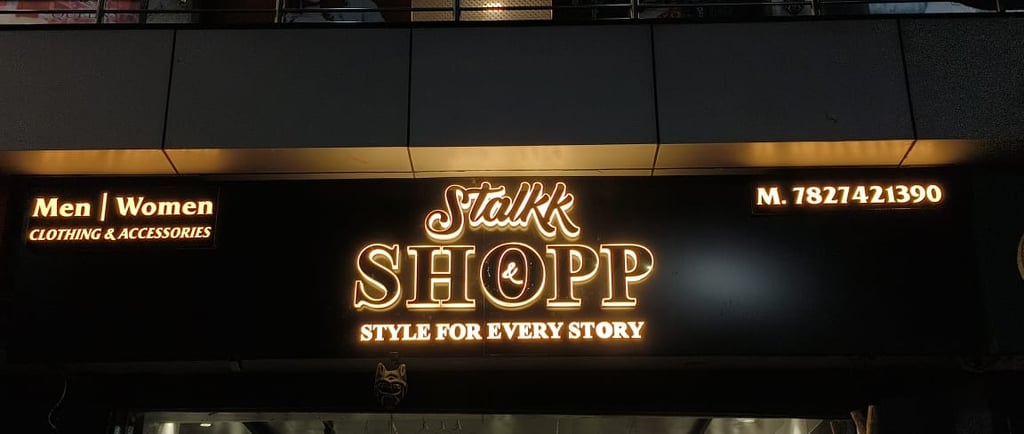The Evolution of LED Sign Boards: Past, Present, and Future
1/23/20255 min read


The Historical Journey of LED Signage
The evolution of LED signage can be traced back to the late 20th century, marking a significant advancement in the realm of visual communication. The introduction of light-emitting diodes (LEDs) revolutionized the way information was conveyed, moving beyond traditional forms of signage such as neon and incandescent lights. Initially, LEDs were utilized in basic applications like indicator lights and numeric displays, providing a glimpse of their potential in the signage industry.
One of the earliest milestones in the history of LED sign boards was the development of the first LED displays in the 1970s. These pioneering devices were primarily used in electronic scoreboards and basic alphanumeric displays. Over the years, advancements in technology lead to the introduction of multi-color LED options, allowing sign makers to create more vibrant and attractive displays. The shift from monochromatic to full-color LED screens marked a turning point, as businesses and organizations recognized the potential of dynamic advertising.
The transition to LED signage gained momentum during the 1990s and early 2000s, fueled by the need for more energy-efficient and cost-effective solutions. Unlike their neon and incandescent counterparts, LED sign boards consumed significantly less energy, which translated into lower operational costs for businesses. Additionally, LED technology offered improved longevity, with lifespan estimates extending beyond 100,000 hours, paving the way for greater acceptance in various applications, from retail storefronts to public transportation displays.
Furthermore, the development of pixelated and modular LED systems contributed to the widespread adoption of LED signage. These systems allowed for greater flexibility in installation and design, accommodating larger, more complex displays. The increased availability of customizable options led to an explosion in the use of LED technology across multiple sectors, ultimately transforming it into a preferred medium for modern advertising and information dissemination.
Current Technologies in LED Signage
LED signage has transformed significantly in recent years, characterized by various types of sign boards that cater to diverse communication needs. Among the most common types are single-color, full-color, and digital programmable displays. Single-color LED sign boards are typically used for clear and straightforward messaging, often seen in traffic signals and basic advertising. In contrast, full-color LED displays enable rich visual content, enhancing marketing efforts through vibrant graphics and videos. Digital programmable displays take interactivity a step further, allowing real-time updates and dynamic messages, making them particularly effective in high-traffic areas.
Recent advancements in LED technology have resulted in notable improvements in energy efficiency, brightness, and lifespan. Modern LED components consume significantly less power than their predecessors, which not only reduces operational costs for businesses but also aligns with growing environmental sustainability initiatives. Advances in brightness technology allow LED displays to remain visible under various lighting conditions, providing optimal visibility and engagement at all times. Furthermore, improvements in manufacturing techniques have extended the lifespan of LED sign boards, allowing for lower replacement costs and reduced waste over time.
Another important aspect of current LED signage technologies is the integration of smart technologies and automation. Today’s LED displays can be connected to various data sources, allowing businesses to tailor their messaging based on real-time metrics, such as foot traffic and seasonal trends. This level of adaptability enhances marketing effectiveness and customer engagement. Additionally, regulatory aspects play a crucial role in shaping the use of LED signage. Local regulations often dictate brightness levels, size, and content specifications, influencing how businesses can utilize this technology. The impact of commercial demand and environmental considerations continues to be significant, driving the evolution of LED signage toward smarter, more sustainable solutions.
User Experiences and Benefits of LED Sign Boards Today
Modern LED sign boards have become instrumental in enhancing communication and advertising strategies for various businesses. Through their vivid displays and dynamic content capabilities, LED signage offers unprecedented opportunities for engagement with target audiences. One of the primary advantages of LED sign boards lies in their energy efficiency and longevity, which can significantly reduce operational costs compared to traditional signage solutions. This efficiency translates into a remarkable return on investment (ROI), making LED boards a prudent choice for businesses focused on maximizing their marketing budgets.
Several industries have successfully adopted LED sign boards to elevate customer experiences. For example, in the retail sector, businesses utilize dynamic pricing displays and promotional messaging to attract foot traffic and enhance sales strategies. A noteworthy case is a prominent retail chain that observed a 20% increase in sales after integrating LED displays to showcase real-time discounts and special offers. Similar success stories can be found in the hospitality industry, where hotels use LED signage to communicate essential information such as room availability, event schedules, and special promotions, thereby enriching the guest experience.
Transportation hubs are also leveraging the capabilities of LED sign boards for enhanced safety and communication. Airports and train stations utilize these displays for real-time updates on schedules and boarding information, contributing to smoother passenger flows and improved operational efficiency. As a benefit, travelers can remain informed without the need for manual announcements, thus reducing congestion and confusion.
Importantly, the advancement of LED technology has made it accessible for smaller businesses as well. Many local enterprises have begun to integrate LED signage into their marketing strategies, finding that it amplifies their visibility at a fraction of the cost of more extensive advertising campaigns. User feedback is vital in shaping future iterations of LED technologies, driving innovations that prioritize user experience while addressing common challenges in installation and maintenance.
Future Trends in LED Signage: What's Next?
The future of LED signage is poised for significant transformation, driven by technological advancements and evolving consumer demands. One of the most anticipated trends is the development of higher resolution displays. As the demand for clearer and more captivating visual content grows, manufacturers are expected to focus on increasing pixel density, enhancing the overall viewing experience. Higher resolution displays will provide sharper images and more vibrant colors, making LED signs an even more effective medium for advertising and communication.
Additionally, the integration of augmented reality (AR) with LED signage is likely to reshape the landscape of outdoor and indoor advertising. By using AR technology, businesses can create interactive experiences that engage consumers in compelling ways. For instance, potential customers could use their smartphones to view additional information or virtual promotions alongside physical displays. This convergence of digital and physical advertising could significantly elevate marketing strategies, making them more dynamic and personalized.
Moreover, the advent of Internet of Things (IoT) connectivity holds the potential to revolutionize LED signage management and functionality. IoT-enabled LED signs can facilitate real-time data analytics, allowing businesses to adjust their content dynamically based on audience behavior or environmental conditions. Such capabilities will enhance the effectiveness of advertising campaigns and improve operational efficiency through automated updates.
Another critical consideration for the future will be environmental sustainability. As public awareness of environmental issues increases, manufacturers will need to adopt eco-friendly practices in the production and disposal of LED signage. This could include the use of recyclable materials, energy-efficient technologies, and measures to reduce electronic waste. Addressing these concerns will not only comply with future regulations but also resonate with environmentally conscious consumers.
Lastly, potential regulatory challenges may emerge, necessitating compliance from manufacturers and advertisers. Monitoring industry norms and regulations may become crucial to navigating the changing landscape of LED signage. Overall, the future trends in LED signage promise to be exciting, with innovations that enhance functionality, sustainability, and consumer engagement.
